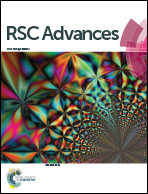Electrochemical amination of graphene using nanosized PAMAM dendrimers for sensing applications†
Abstract
In this work, a graphene film was electrochemically functionalized by anodic oxidation of amine terminated PAMAM (4th generation PAMAM-(NH2)64) dendrimer molecules via a covalent linkage (C–N) between graphene and PAMAM. This simple functionalization provides ≈37.51 × 1015 PAMAM molecules per cm2 on the versatile graphene, which is eleven times higher than the PAMAM molecules attached on the glassy carbon electrode (3.33 × 1015 molecules per cm2). Thus, the facile electrochemical functionalization route on graphene yields a high density of amine functional groups on graphene which offers an opportunity to load a larger number of enzymes, proteins, DNA, antibodies, antigens, etc. to develop highly sensitive graphene based bio and chemical sensors. To demonstrate this with a model, the horseradish peroxidase enzyme was immobilized onto the functionalized graphene film to detect H2O2. The as constructed platform shows enhanced electrocatalytic activity, high storage stability up to one month, lower applied potential and exhibits a high sensitivity of 29.86 μA mM−1 cm−2 which was 5 times greater than the functionalized GCE for the detection of H2O2. The sensor was also used to detect H2O2 in human serum to testify the feasibility of the sensor in practical application. These results demonstrate that the electrografting of PAMAM on graphene is a promising approach for the fabrication of the sensors which exhibit enhanced electrocatalytic activity, sensitivity and stability.


 Please wait while we load your content...
Please wait while we load your content...